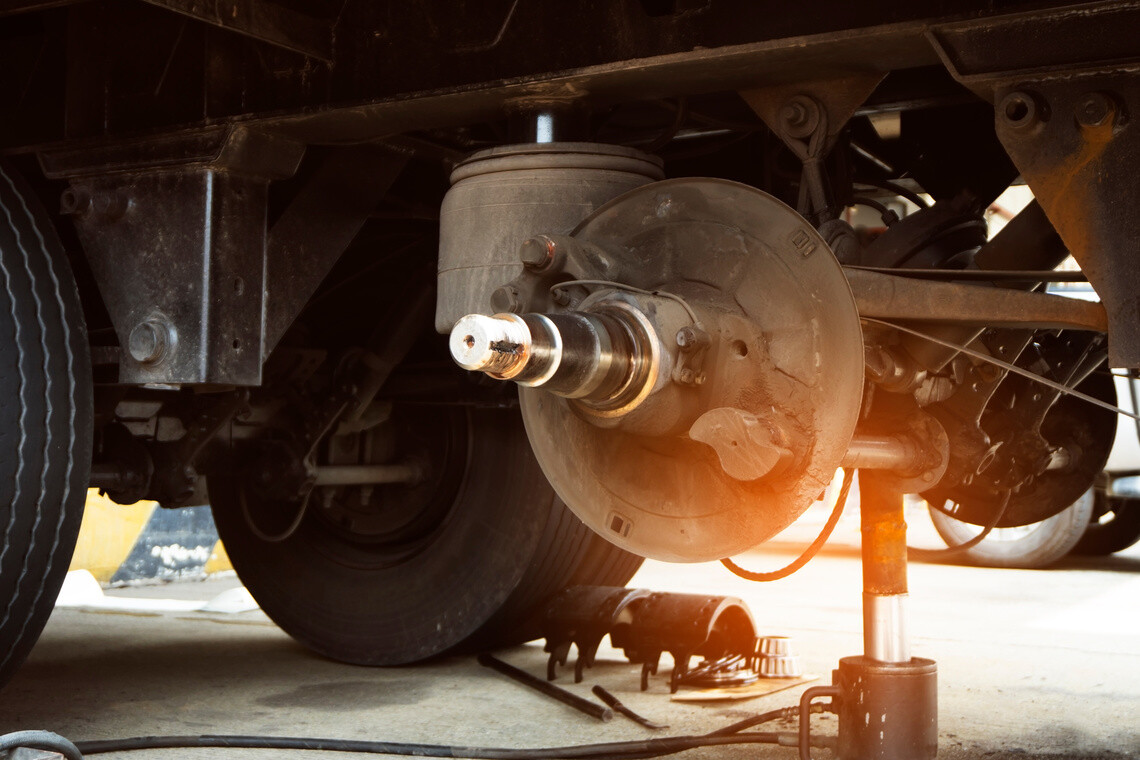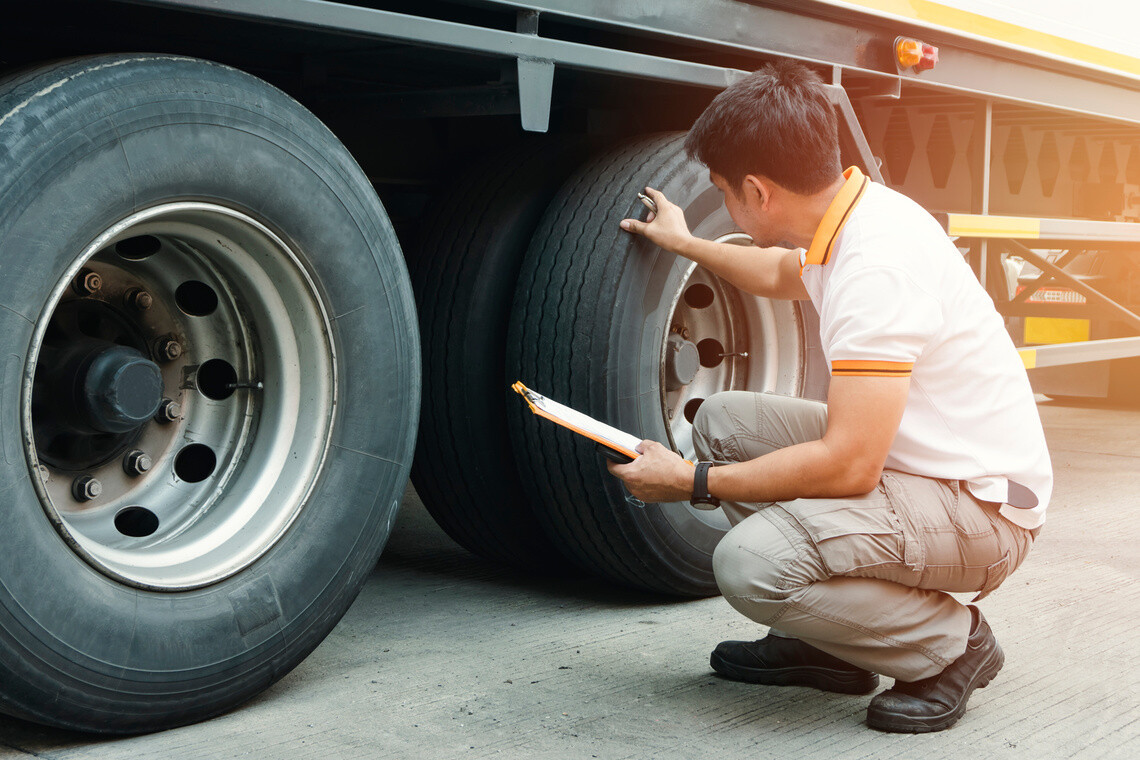
Brakes of a semi truck
Properly maintaining truck braking systems can result in a more efficient, productive, and safer fleet operation.
Maintaining a fleet of trucks is perhaps the biggest job a fleet manager must oversee. Truck maintenance is crucial for safety, but it can cause downtime for repairs, affecting productivity and profits.
While this is a short-term inconvenience for truck drivers and their direct managers — downtime caused by preventive maintenance schedules will, in fact, improve productivity by maximizing uptime and more importantly, safety.
But as evidenced by Commercial Vehicle Safety Alliance (CVSA) annual Roadcheck and spot inspection events in recent years, a sizeable number of fleets are neglecting some key, basic components in their maintenance programs.
Chief among these components are semi truck braking system maintenance. The results of having faulty brakes are serious, including:
- · An unsafe vehicle that could result in a serious crash and ruinous liability payments.
- · A vehicle and driver put out of service.
- · A citation that includes both points against a driver and fleet’s safety score and the possibility of a big fine.
However, fleets can take positive steps to reduce risks on the road, while maximizing uptime and productivity.

Doing a routine maintenance safety check on truck
Technician doing a routine safety and maintenance inspection on a truck.
The High Cost of Inadequate Brake Maintenance
In May 2023, the CVSA Roadcheck inspected 59,429 commercial vehicles in the U.S., Canada and Mexico. This resulted in 17,479 vehicles and 3,256 drivers being put out of service. The main reason for out of service violations is braking systems, accounting for 25.2%, followed by tires at 19.3% and defective service brakes at 14.1%.1
Putting a vehicle or driver out of service for any reason is serious, but if it is for braking systems, there's potential serious safety lapses in the overall maintenance program and the required, daily driver vehicle inspection report (DVIR).
The safety factor is pure physics; without an adequate braking system, there is no way a driver can safely bring a vehicle — which weighs tens of thousands of pounds — to a complete stop. To put this in perspective, a fully loaded tractor trailer weighing 80,000 pounds and traveling under ideal (daytime, dry, flat) conditions at a speed of 65 mph will take 525 feet to stop — about the length of two football fields.2
The potential for liability is significant. For example, so-called “nuclear” verdicts against large trucking companies are becoming more common, reaching into the tens and even hundreds of millions of dollars.
Beyond direct liability costs, damage to the company’s brand could be just as ruinous and long lasting, resulting in the potential loss of customers and drivers. The cause in both instances is the same; the fleet is seen as unsafe.
This is only one leg of the liability stool. The driver and fleet will also likely be assessed CSA points — counted for 24 months following the violation — which goes against its safety score and could affect the company’s ability to get or retain business or affect its insurance premiums. The fleet’s CSA status is posted publicly by the Federal Motor Carrier Safety Administration (FMCSA). This will reinforce in the minds of the public (who may be potential customers) that the fleet is unsafe.
The points value of a braking system violation isn’t the highest. For either a general brake violation or a brake(s) out of adjustment, the violation is 4 points each.3 But where there is one violation, it can be expected that others may follow. Often, a vehicle or driver may be found to have other violations, which could net even more points, and in worst-case scenarios, trigger a time-consuming and expensive audit of the fleet by federal regulators.
Finally, while the points will flag the fleet’s potential safety deficiencies at the time and could hurt the fleet (and its company)’s ability to do business, they also bring with them substantial fines reaching into the tens of thousands of dollars or more for each vehicle, depending on the seriousness of the infraction. For example, if the fleet continues to operate the vehicle even after it was cited for having faulty brakes, it could face a fine for that single infraction of $26,000 or more.4
Implementing a Brake Safety Program
While the consequences of lacking a strong brake maintenance program could be catastrophic, implementing a safety program is relatively straightforward, relying on both the maintenance team and the driver for success.
On the maintenance side, establishing a strong preventive program that includes regular inspection and service of all brake components will standardize practices throughout the fleet. The PM program can be a component of the fleet’s overall safety strategy, and include:
- · Correcting brake adjustment, either manually or, if equipped with automatic slacks, assuring adjuster rates of travel is correct.
- · Antilock brake system warning light operation.
- · Inspection of air hoses and tubing, preferably with the brakes applied.
- · Assurance that all hardware is in place and secure.
- · Proper thickness of lining and drums exists.
- · No presence of air leaks.
- · The low air warning system operates properly.6
In addition, fleets can consult the CVSA Inspection Level I guidelines to further align the PM program to the elements inspectors will be evaluating in the field.6
brake safety infographic
Getting Fleet Drivers involved
Drivers are a key part of keeping braking systems in working order and should be doing their part due to the requirement to complete a daily pre-trip driver vehicle inspection report (DVIR). It's important for drivers to take the report and inspection seriously to ensure safety on the road.
Fleet staff should regularly check that their drivers are doing their vehicle inspections properly. This is an important part of the safety program that they are responsible for. Regular spot checks and training will keep the importance of the DVIR top of mind for drivers. In addition, there are electronic solutions that can help further strengthen the DVIR process.
While it’s crucial to hold drivers accountable for keeping their vehicles up and running, the truth is that most drivers are committed to having safe, well-maintained vehicles — since it is in their best interest. That means it’s incumbent on fleet and company leadership to create a culture that encourages and reinforces safety.
The direct benefit isn’t just a vehicle that is well maintained and productive; it is how a company will retain their best and safest drivers. In fact, a strong maintenance PM program should be one of the pillars of your driver retention plan.
With a truck driver shortage, finding and retaining good, safe, productive drivers is one of the biggest challenges facing the trucking industry today. Drivers leave companies for a number of reasons, including: poor pay, time away from their family, scheduling issues, conflicts with supervisors, and poor quality equipment.6
Keep in mind that a driver’s job is to operate a vehicle and transport a load from point A to point B safely and not time dealing with maintenance issues.7
Having trucks that break down constantly will cause drivers to be frustrated and affect their relationship and confidence in the company.6 And, worse, if drivers think their vehicles are unsafe, it will make it difficult to retain drivers and hire new ones.
In today’s connected world, word about the way a company treats its employees — both good and bad — will get out. You want to do all you can to get positive feedback from employees so you can recruit and retain the best drivers possible. Investing in maintenance is one of the ways you can stand out from the crowd.
During the PM process, collect data on the condition of all parts such as brakes to identify when replacements are necessary. This helps enhance the PM program by establishing maintenance benchmarks. This improves the PM program by setting benchmarks for maintenance.
Going for the Win: Consider Outsourcing Trailer Maintenance
With large numbers of Baby Boomers retiring, the need for technicians will grow. There is a need for about 80,000 diesel technicians in the U.S. today. The Bureau of Labor Statistics predicts there will be about 28,100 new openings each year from 2022 to 2032.8 With this continued shortage of technicians, it makes it hard for fleets to service all their assets, especially trailers. Fleets often overlook trailers.
Fleets can save resources by hiring outside help for trailer maintenance.
Of course, outsourcing can cause some concerns and complications. For instance, using multiple vendors could lead to inconsistent work and unpredictability. Fleet stakeholders may lack confidence that the operation is meeting their needs related to:
- · The quality of the workmanship.
- · Timeliness of repairs or the ability to meet roll time targets.
- · Adherence to the fleet’s specifications or standards.
Outsourcing can improve fleet maintenance and deliver high-quality results, similar to what an internal operation would achieve. Choose a good partner to help plan and budget, and give updates on repairs. They should be clear and reliable.
1. “CVSA Releases 2023 International Roadcheck Results.” CVSA. July 31, 2023. https://www.cvsa.org/news/2023-roadcheck-results/.
2. “Trucks Need More Time to Stop.” Utah Department of Transportation. 2020. https://trucksmart.udot.utah.gov/motorist-home/stopping-distances/.
3. “Top 25 Driver, Vehicle, and Hazmat Violations of 2019.” Hansen, Daren. Transportation Regulatory Alert. Aug. 31, 2020. https://www.jjkellerlibrary.com/news-article/top-25-driver-vehicle-and-hazmat-violations-of-2019.
4. “U.S. DOT Increases Fines for Violations.” Medallion Transport & Logistics. Aug. 1, 2019. https://medalliontrans.com/us-dot-increases-fines-for-violations/.
5. “Avoiding Brake-Related Out-of-Service Incidents.” Stanton, Bob. Truckinginfo.com. March 17, 2020. https://www.truckinginfo.com/353436/avoiding-brake-related-out-of-service-incidents.
6. “Truck Driver Retention Strategies: How Telematics Can Help.” Rondini, Denise. Geotab.com. Feb. 2, 2021. www.geotab.com/blog/truck-driver-retention-strategies/.
7. “5 CDL Truck Driver Retention Strategies.” Gupta, Akshat. Drivemyway.com. April 29, 2019. http://hiring.drivemyway.com/employer-blog/5-cdl-truck-driver-retention-strategies/.
8. "Mike Rowe on diesel technician shortage: 'The math ain't good.' FleetOwner.com. May 26, 2022. https://www.fleetowner.com/operations/article/21242644/mike-rowe-on-diesel-technician-shortage-the-math-aint-good.




